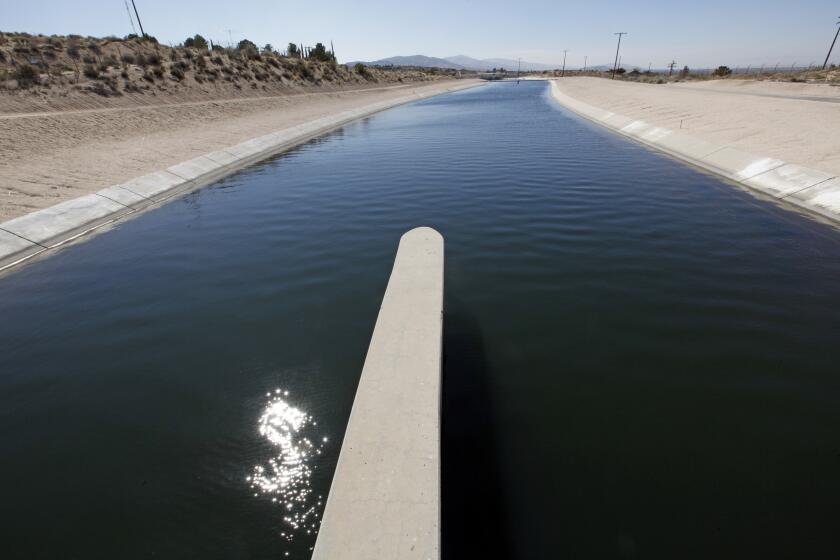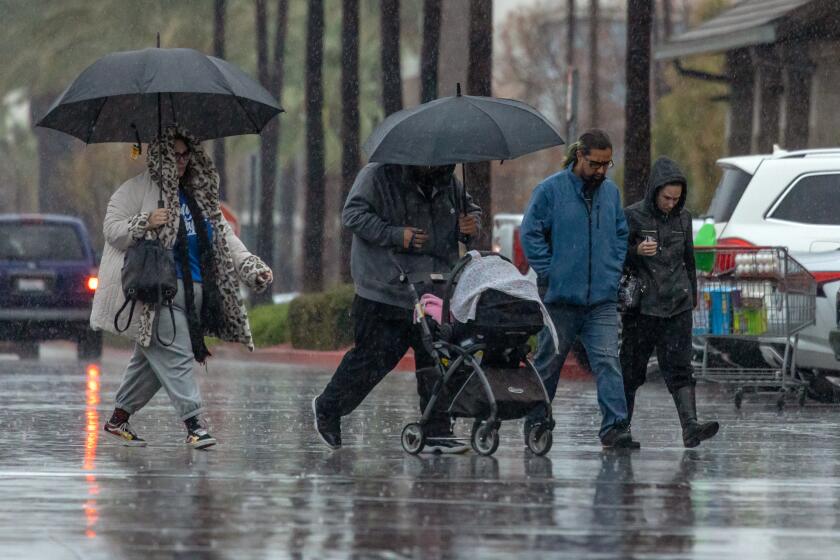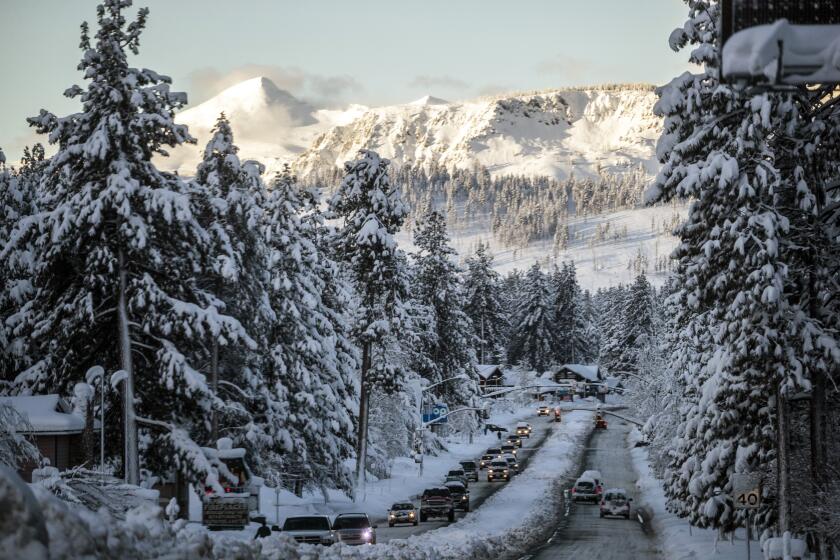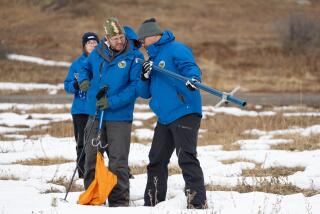Epic California snowpack is now the deepest it’s been in decades
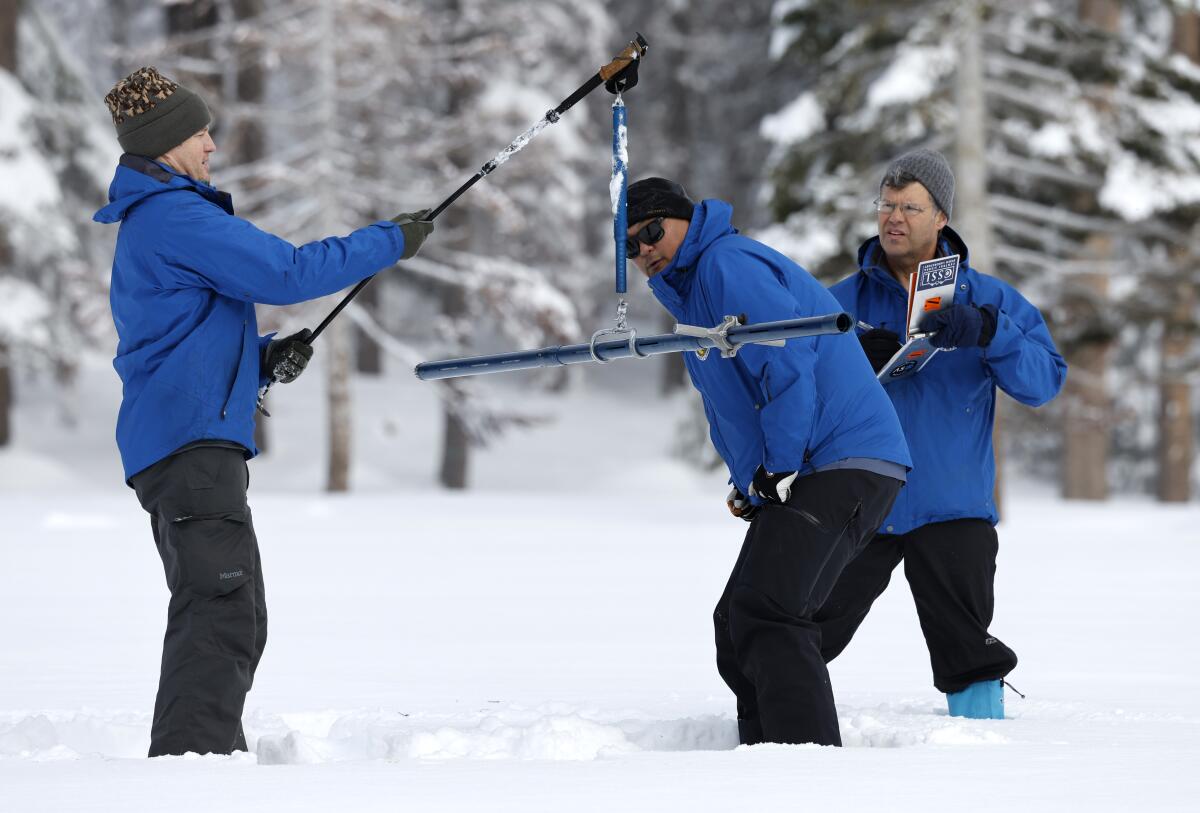
Drought-weary California is entering February with deeper snowpack than it has seen in four decades, reflecting a healthy boost in the state’s supply of water but also spurring concerns about dryness, flooding and other potential hazards in the months ahead.
Statewide Sierra snowpack was 205% of normal for the date on Wednesday, said officials with the Department of Water Resources during the second snow survey of the season.
Even more promising, snowpack was 128% of its April 1 average, referring to the end-of-season date when snowpack in California is typically at its deepest.
“Our snowpack is off to an incredible start, and it’s exactly what California needs to really help break from our ongoing drought,” DWR snow survey manager Sean de Guzman said. The state’s snowpack is currently outpacing the winter of 1982-83 — “the wettest year on record dating back about 40 years,” he said
Snow levels at Phillips Station near South Lake Tahoe, where the monthly surveys are conducted each winter, were 193% of average for the date.
After January storms, the California Department of Water Resources raises its allocation to state water agencies to 30% from 5% only two months ago.
California’s snow is a vital component of the state’s water system, providing about one-third of its supply. Snow is particularly important in the hot, dry months of summer, when it slowly releases more water as it melts.
This year’s bounty is the direct result of the atmospheric river storms that pounded California at the end of December and into January, De Guzman said. The storms dumped trillions of gallons of moisture onto the state, replenishing reservoirs and burying mountain areas under several feet of powder.
It was enough for DWR to tentatively increase its allocation of supplies for the state’s water agencies from 5% to 30%. But officials on Wednesday expressed some concern about the state’s recent return to dryness.
“We really don’t know, here on Feb. 1, whether or not this is the peak of our snowpack,” DWR director Karla Nemeth said. She added that it’s “too soon to tell” if the wet January is enough to break the state’s drought.
“While today’s results are good news for water supplies, we know from experience how quickly snowpack can disappear if dry conditions return in the months ahead,” she said.
There’s no denying January started off strong. On Monday, the UC Berkeley Central Sierra Snow Lab at Donner Pass reported that it had reached a season total of 360 inches — a number it usually averages in an entire year.
“Generally when we get to that average point, it’s much later in the year,” said lead scientist Andrew Schwartz. “We’re hitting that effectively three months ahead of schedule, which is absolutely fantastic. We’re definitely in a terrific position going forward.”
While previous years have seen denser snow — meaning more water in the snowpack — Schwartz said Wednesday that the amount of snowfall was the highest the lab had seen since its digitized records began in 1971.
Under normal conditions, there aren’t many downsides such a substantial start to the season, he said — with a couple of exceptions.
“If we go outside of normal conditions and we get something like another rain-on-snow event that’s very warm, it can produce some pretty substantial and catastrophic flooding,” he said. “Because rain likes to melt the snow.”
Indeed, state officials said flood management will be a factor as the snow begins to melt into runoff. Depending on how quickly the snowmelt occurs in April or May, it could have the potential to overwhelm reservoirs downstream.
A series of January storms has left soils dampened and snowpack above average. Will this curb the upcoming fire season? Experts say it all depends
Adding to the challenge is that seasonal forecasts remain inconclusive, showing near equal chances of wetness or dryness in much of the state through April, meaning water managers must prepare for all scenarios.
“It’s a little bit of both right now — a flood and a drought management [situation],” said David Rizzardo, DWR’s hydrology section manager. Officials are “trying to maximize storage while minimizing threats to downstream communities should the runoff accelerate from the snow or future rain events.”
On top of that balancing act is the possibility of evaporation as the state’s atmosphere gets warmer and drier because of climate change.
In 2021, the state reported a steep decline in runoff from snow that was largely due to warm temperatures and snow seeping into dry soils, Nemeth said.
“Warming temperatures are an increased demand on our available surface water, and those are the things that we’re watching very closely that can affect our runoff into rivers, streams and reservoirs,” she said.
Schwartz, of the snow lab, said all the precipitation in California could also result in additional growth of grasses, especially at lower elevations, which can lead to wildfires in the summer.
But, he added, “I think the benefit of having a snowpack this big far outweighs any of those risks.”
California snowpack is 174% of average for this time of year, but state officials caution that the drought isn’t over.
There have been other benefits, too. The storms, which came on the heels of the state’s driest three years on record, moved all of California out of the worst two categories of drought — extreme and exceptional drought — according to the U.S. Drought Monitor. Just three months ago, 43% of the state was under those classifications.
Reservoirs also saw a boost. Lake Shasta ended January at 56% capacity, up from 33% a month prior. Lake Oroville was at 65% capacity, up from 36% at the end of December, according to state data.
Yet the severity of California’s drought will likely take more than one wet winter to fully recover from, officials said. While the state’s surface is snow-capped and wet, groundwater supplies remain perilously depleted.
What’s more, Southern California’s other major water supply, the Colorado River, is still at crisis levels.
But that hasn’t stopped Californians from enjoying the powder. At the Sugar Bowl Resort near Lake Tahoe on Wednesday, spokesman Jon Slaughter said the snow was so deep he couldn’t see out of his second-story window.
“It’s shaping up to be a great year,” Slaughter said. “We’ve been seeing great snowfall, and we’ve got another foot coming in this weekend.”
More to Read
Sign up for Essential California
The most important California stories and recommendations in your inbox every morning.
You may occasionally receive promotional content from the Los Angeles Times.
